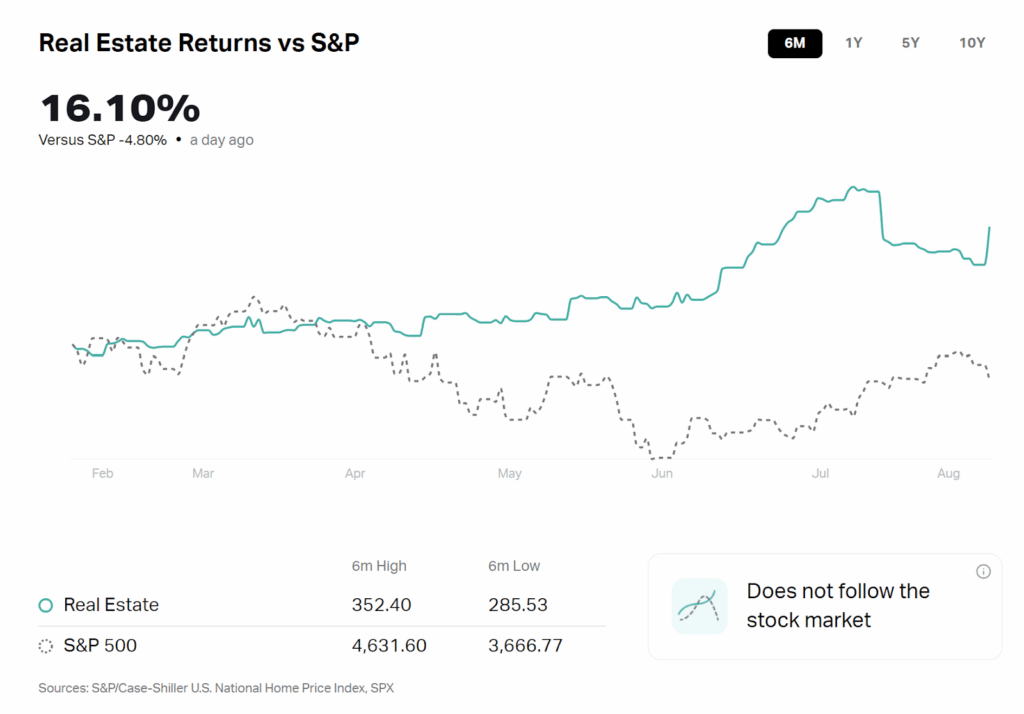Survival of the Fittest: How to Hedge Against Stocks
During a market downturn, you can hedge stocks by investing in alternative assets, options, and more.

It’s easy to panic when stocks take a nosedive and you see your investments fall with them. But don’t fret. You can ease the blow by taking advantage of assets that increase in value when stock prices plummet.
There have only been 14 bear markets since 1945, which translates to about one every five years.
So let’s explore some alternative assets to see how you can protect your portfolio from bear markets and even recessions.
How to hedge stocks
You’ve heard this before, and you’ll hear it again: Don’t keep all your eggs in one basket. Diversifying your portfolio with a good mix of stocks, bonds, cash, and alternative assets is a time-tested way to keep your portfolio on track, even when the bear market dominates headlines.
But building a diversified portfolio is easier said than done. In fact, if you’re heavily invested in assets that tend to move in line with the market, you may not be diversified at all.
Diversify your portfolio.
One of the best stock hedging strategies is ensuring that your portfolio gains exposure to stocks and assets typically uncorrelated with stocks. To identify these stocks, many investors turn to the Pearson correlation coefficient. This statistical formula measures the historical relationship between different asset classes.
The coefficient ranges from -1 to 1. Positive numbers indicate that two assets tend to move in line with each other, while negative numbers suggest that an asset class moves in the opposite direction to another.
- Bonds: Investing in bonds is a popular way to hedge stock investments. Bonds provide a steady income stream, and their prices tend to move in the opposite direction of stocks. Investing in bonds can help to protect your stock investments from drops in the stock market.
- REITs: Real estate investment trusts (REITs) are a type of investment that allows investors to invest in real estate without taking on the risk of direct ownership. REITs can provide a hedge against stock market volatility as they are less sensitive to market fluctuations.
- Gold: Gold is a precious metal that can be used to hedge investments in stocks. Gold prices tend to move inversely to stock prices, so when stock prices go down, gold prices tend to go up.
- Options: Options are contracts that give the buyer the right to buy or sell an asset at a predetermined price. Options can be used to hedge stock investments by allowing investors to protect themselves from price fluctuations. By purchasing a put option, investors can protect their stock investments from large price drops.
Best stock hedging strategies
Let’s focus on assets that have historically gone up when stocks went down. We’re going to look at traditional assets like bonds and alternatives like real estate and gold to see which is the best to hold during a market decline.
Bonds
Based on our asset-correlation study, we found that bonds have had the lowest correlation to stocks monthly from 2018 to 2021. The correlation was -0.3380.
Bonds are considered low-risk assets because you’re essentially lending money to a company or government that promises to pay it back with interest. For instance, Treasury bonds are backed by the full faith of the United States government. Treasury bonds tend to perform better during recessions because government-backed securities have a track record of being resilient assets.
One of the easiest ways to invest in a diversity of bonds at the same time is by investing in bond ETFs. Think of these as baskets of different bonds, including corporate, municipal, and treasuries, or a composition of bonds.
But remember, low risk means low return potential.
REITs
Real estate investment trusts (REITs) invest in income-producing real estate like strip malls and apartment complexes. Regardless of what happens in financial markets, people are going to need homes, and businesses will need property to operate from.
A study by the investment management firm Guggenheim Investments found that REITs had a moderate correlation of 0.68 to the S&P 500 between January 2011 and December 2021. This could mean REITs are good tools for long-term stock hedging.

Moreover, REITs must pay out 90% of their earnings to shareholders as dividends. You can invest in publicly-traded REITs as you would an ordinary stock through an online trading platform. REITs also exist as ETFs and mutual funds.
However, it’s important to note that our study found REITs to have the highest correlation to stocks. This may have been due to how the pandemic triggered closures of strip malls and stores in which REITs invest in.
Our study also found that private REITs may be less correlated to stocks and thus better potential stock hedgers. But the barrier of entry is immensely high as they can only be sold to institutional investors. The best alternative to residential real estate is agricultural REITs because their correlation with CPI makes them excellent inflation-resistant assets fit for risk-averse investment portfolios.
Gold
Gold historically has been viewed as a hedge against inflation and bear markets. Our data found that gold is moderately correlated to the S&P 500. In fact, the price of gold soared as the market plummeted during The Great Recession. The precious metal again fared well during the COVID-19 recession as the price of gold reached an all-time high of $2,062.50 per ounce, making it one of the best investment commodities. And with fears of an upcoming recession permeating the news cycle, gold may shine once more.
But how does one even invest in gold if you don’t have a giant vault and a small army to protect it? While it’s not as glamorous, you can invest in gold through gold ETFs. These are funds that aim to match the performance of the overall gold market. If you want to invest in gold directly, the easiest way is through an investing platform like Hard Asset Alliance.
So if gold moves high, you can win big. But be warned, you can lose if it doesn’t. SPDR Gold Shares (GLD)—a benchmark for the gold market—has been down year-to-date.
But as far as its resistance to a major market downturn like a recession, it may be too close to call.
Hedging the stock market with options
An option contract gives you the option (but not the obligation) to buy or sell a stock at a specific market price—the strike price—within a given time frame. An options contract is a great way to bet on the price of an underlying security, but they’re also a fast way to lose money if you don’t know what you’re doing. For hedging purposes, let’s focus on put options contracts.
A put option is the right to sell shares of an underlying asset at a determined strike price before the contract expires. During that time, traders can buy and sell the put options at a range of strike prices for a premium. The put options can be exercised when the current market price of the stock goes below the strike price.
Let’s say you buy a company’s stock at $20 a share. You’re bullish and think it will go up, but you want some downside protection. So you pay a small fee called a premium to purchase a put options contract with a lower strike price of $15 that expires in one year. Eight months later, the stock price dropped to $12, but you can exercise your contract and sell the stock for $15 even though its market price is $12. In the end, you lose $5 instead of $8.
Put options don’t necessarily mean buying rising assets to offset losses as a hedging strategy, but are more of a way to mitigate losses from the asset itself—like the stock that depreciated in our example. If you want to jump into options, you can do so through most brokerage accounts and trading platforms like TradeStation. You can also use them to buy a futures contract or just regular stock trading.
Put options enable you to hedge against downside risk, but options trading also means taking on risks and is generally intended for advanced traders. Plus, you need to pay premiums for options contracts on top of the strike price. Premiums are generally higher for options contracts to trade stocks that are historically more volatile. In other words, the riskier the stock, the pricer it is to bet on the market price.
The bottom line
Bear markets are a part of life. But historically, they have been short-lived. There have only been 14 bear markets since 1945, which translates to about one every five years. So this means that if you stray too far from stocks, you may not benefit as much from the gains. Some traders even buy put and call options at the same strike price, which is called a straddle.
A study by the asset management company Hartford Funds found that Stocks lose 36% on average in a bear market. By contrast, stocks gain 114% on average during a bull market.
Overall, portfolio protection should enable you to weather the storm and hedge against stock losses. Consider the traditional stocks, bonds, and cash portfolios, but also look at assets that may not be correlated, such as real estate and gold.
